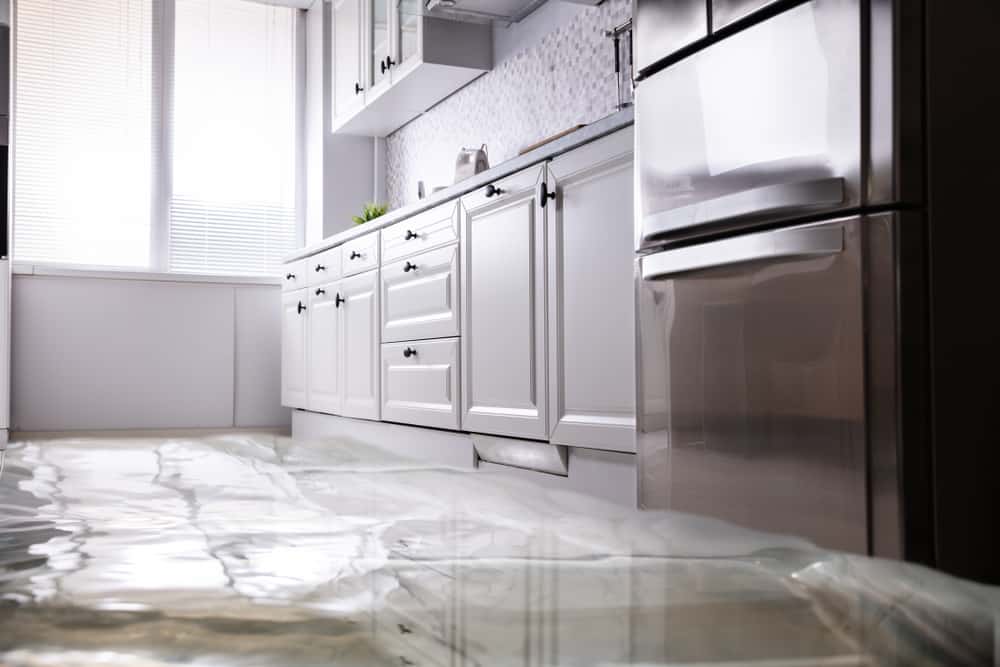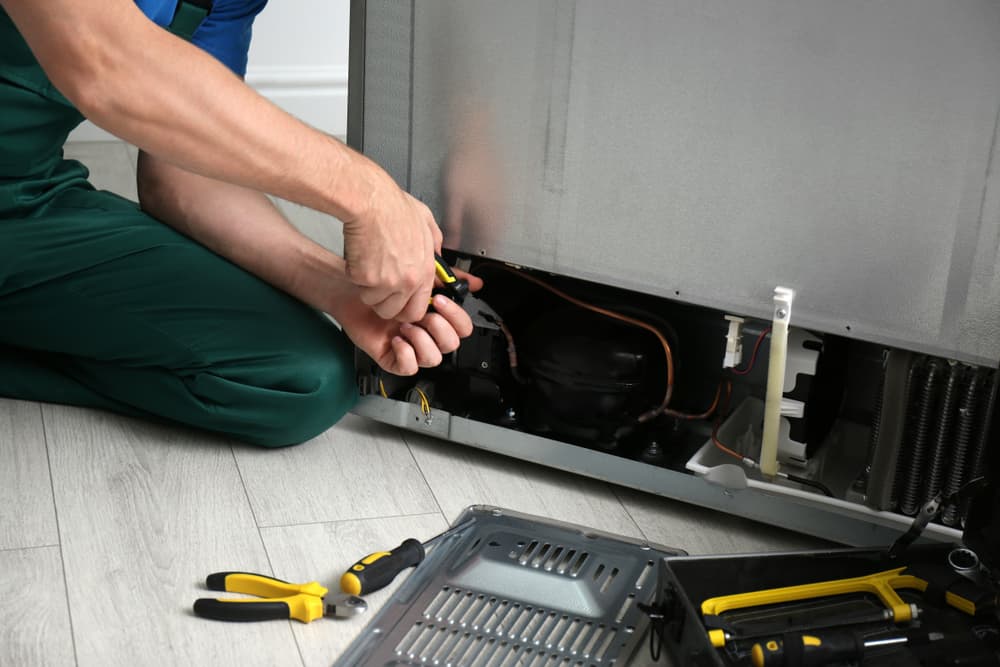Home-use refrigerators have been making our lives convenient since 1913, but like all kitchen appliances, they require maintenance. If your fridge is leaking a clear oily substance, there could be a few reasons.
There's nothing more critical for your peace of mind than a working fridge. That's why I have dedicated so much time to this blog to answer everyone's questions about kitchen procedures and appliances.
This post looks at "My fridge is leaking a clear oily substance - what could it be?"

Water from a refrigerator leaking on to a kitchen floor
Several substances can leak from your refrigerator, and there are three primary causes for this refrigerator issue. I'll be discussing all three, what you can do about them, and if it is necessary to call for professional help.
The substance leaking from your refrigerator is likely one of three things:
Thankfully, each substance links to a different issue, making the problem easier to identify. Let's look at the three most probable causes for these fridge leaks.
Refrigerators have short-lived defrost cycles regularly to stay in top condition. The defrost drain rests in the freezer section of your fridge, and sometimes it can clog up. Water often leaks out of the refrigerator when this happens. This water may catch food particles and other residues, making it feel oily or sticky.
If your defrost drain is blocked, you may also notice ice maker or water line performance issues.
A clogged defrost drain is often due to ice buildup, but grime and dirt can also stall the pipes. Fortunately, this is the easiest solution to remedy, and you don't need any expensive materials, liquid cleaners, or professional help to solve it.
Pour hot water into the drain tube towards the back of your freezer compartment. You can use a thin brush or rag to scrub inside the valve to clean off dirt buildups. After that, flush some water through the pipe to rinse any contaminants. Doing this should get rid of ice in your drain tube.
The clear oil you see leaking may be from your refrigerator's sealed areas. It keeps the cooling system working, but if any of the components busts, it can cause a coolant leak.
The condenser coil, evaporator coil, and drain pan are the parts you need to inspect for leaks. The drain pan (also called a "drip pan") catches oil and runoff from the internal fridge parts, but it will overflow noticeably onto the floor if they leak continually. Let's discuss each of these parts in detail, including how to clean them and inspect them for damage.
The condenser coil is full of refrigerant, helping to keep the fridge interior cool. It resides at the back of your machine towards the bottom. If your condenser coil leaks, you will notice that the fridge temperature is higher than average. You may experience food spoilage, warm water from the dispenser, and a puddle of oil at your feet.
The primary cause of condenser coil damage is corrosion, so you must check for that. Locate the panel on the back of your refrigerator towards the bottom. Use a screwdriver to remove the screws and verify that the coil is intact. Feel its surface to make sure it is cold.
If the coil is warm or has obvious signs of rust, corrosion, or damage, it needs replacing. Fortunately, replacing the condenser coil is more economical than buying a new fridge. However, you should still call a qualified technician for help with ordering and swapping the part.

Inspecting the back of the refrigerator for problems
Unlike the condenser coil, the evaporator module is at the back of the freezer compartment towards the top. The evaporator helps keep the fridge cool by removing heat from the air. Like with the condenser coil, your refrigerator will feel warm if this part isn't working. You can see a clear oil or coolant dripping from the coils if it leaks.
First, unplug the refrigerator. Unscrew and remove the freezer compartment that contains the evaporator coil. Once you can see the part, check for oily spots, rust, or corrosion, which indicate potential leaks. If the component is leaking, it needs repair or replacement.
In some cases, the evaporator coil is fixable by using a vacuum pump, but it is safer to replace the part. Failing to fix the part will incur further repair costs, so I recommend enlisting the help of a professional if you notice the component leaking.
If you need a new evaporator, check your refrigerator manual. Many companies offer limited warranties on these parts that could help you pay for repair or replacement costs.
The drip pan is the last of three parts that can cause coolant leaks. The drip pan's job is to catch liquids that happen to flow from pipes in your fridge, but the oil may spill out if it is cracked or overflowing.
First, unplug your machine. You can view the drip pan by opening the rear panel at the bottom of the refrigerator. You will need a screwdriver to access it. From there, you should be able to assess whether or not the pain is leaking.
Unfortunately, whether or not your drip pan is removable varies based on your fridge model. You should check your fridge user manual to see whether or not you can remove your drain pan. If your refrigerator has a removable pan, you can swap it out for an intact replacement. Otherwise, you may need an entirely new machine, incurring high expenses.
If you can replace the drip pan, securely reinstall the panel screws and replug your machine. The new drain dish will catch small oil leaks and prevent them from running onto the floor around your fridge.
Common Reasons for Refrigerator Leaks
Freon is a gas that works with coolant to keep your refrigerator frigid. If your machine is warm inside, but each of the above components is functional, it could be that the Freon is leaking. You may encounter a higher electricity bill since your compressor will overwork to try to compensate for the leak. Lastly, an oily residue will accumulate on the floor.

If you can’t find a quick solution, it may be time to call the appliance repair pros
Freon can cause serious health complications if you inhale it, so I advise calling an appliance repair specialist for help with fixing and replacements. However, there are two ways you can test for a Freon leak.
First, you can invest in a leak detector. Most of these devices are sensitive to halogens in the air and will be able to detect if Freon is present.
Secondly, you can use a home method. Mix some dish soap with water in a spray bottle, and then apply the mixture to the coils at the back of your fridge. If tiny bubbles appear, it means gas is escaping through that component, indicating a Freon leak.
